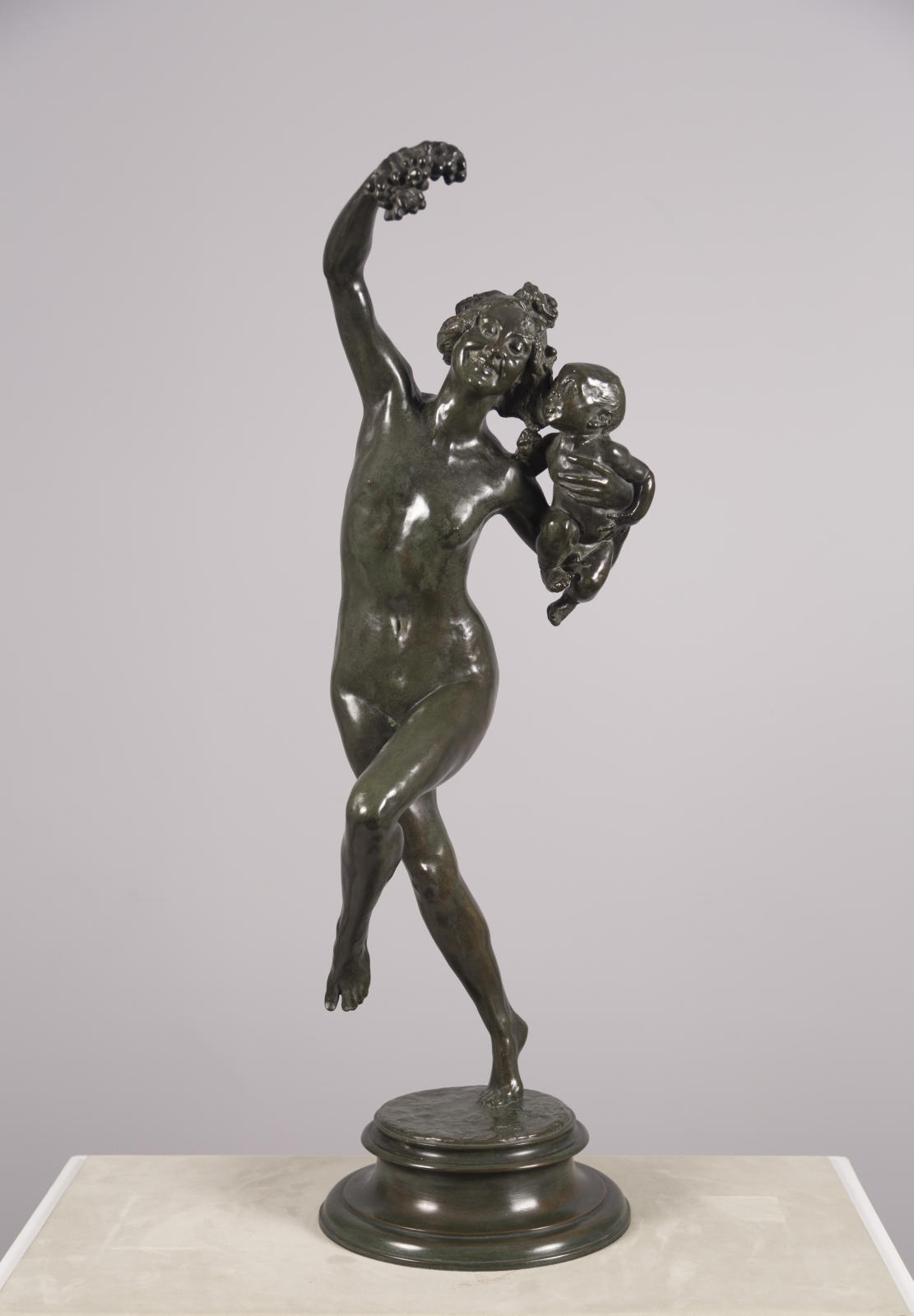



Base: 10 inches diameter
Marked: Roman Bronze Works N-Y- 1894
artist
Frederick MacMonnies, born in Brooklyn, New York started his career by working as a studio hand for Augustus Saint-Gaudens (1848-1907). Soon afterwards, MacMonnies enrolled in modeling classes at the Cooper Union and drawing classes at the National Academy of Design. In 1884 MacMonnies moved to Paris and spent time at the Académie Colarossi and the École des Beaux-Arts. Unfortunately, a cholera epidemic broke out in Paris and forced him to leave. Subsequently, MacMonnies traveled to Germany and then back to the United States, where he spent another year working with Saint-Gaudens before returning to Paris to begin a two-year tenure at the École des Beaux-Arts. At this time MacMonnies also worked in the studios of Jean Falguière and Antonin Mercié.
MacMonnies’s first artistic achievement which helped to establish his reputation was his plaster model of Diana, which he exhibited at the Paris Salon in 1889. MacMonnies was then commissioned internationally to create many sculptures and, although he chose to live in Paris, many of his public and private sculptural commissions were in the United States.
In 1893 MacMonnies received a fifty thousand-dollar commission for the World's Fair Exposition in Chicago. The work he created for this commission titled The Barge of State, a thirty-eight figure extravaganza, made him internationally famous.
Frederick MacMonnies was one of the first American sculptors to recognize the potential market of the middle class. He created a system, therefore, where he copyrighted his works and then contracted with foundries to produce some of his figures in multiple sizes.
Description
No American sculpture in the Metropolitan Museum’s collection has received more intense public scrutiny than MacMonnies’s Bacchante and Infant Faun. MacMonnies modeled the work in 1893-94, following the triumphant reception of his Columbian Fountain at the World’s Columbian Exposition in Chicago. He chose as his subject a dancing female figure whose appearance had been forming in his imagination:
“I returned to Europe and went to Paris and started to work on my Bacchante. I had made this design long before, but I never found a model for it. I feel sometimes that the model creates the work. Then a woman came in and I said, “There is my Bacchante!” It was the real Bacchante, who used to laugh herself right out. I created this thing, and she was just what I wanted. She was just nineteen.”
The sculpture captures the nude young woman in exuberant motion, her right toes on the ground and her right arm holding a bunch of grapes high over her head. Her left knee pushes upward in a dancing motion, and with her left hand she secures the nude infant sitting in the crook of her elbow. The woman’s eyelids are lowered, and her mouth is pulled in a toothy grin; the baby looks toward the grapes with an open mouth.
For some years the identity of the model was a mystery, but a drawing by MacMonnies’ childhood friend Charles Dana Gibson, A Café Artist (1894), that depicts MacMonnies and a woman seated together in a Parisian café provides the solution. In an inscription on a reproduction of the drawing, MacMonnies identified the model as Eugénie Pasque, who had previously posed for one of the rowers in the Barge of the State for the Columbian Fountain.
The original bronze Bacchante (the one at the Metropolitan Museum) was cast at Thiébaut Frères in 1894 and exhibited that year in the Paris Salon. There it was greeted enthusiastically by critics and artists for its elegant form and spiraling motion. After the Salon closed, the French government ordered a cast for the Musée du Luxembourg. MacMonnies was the first American sculptor to receive this honor.
provenance
Private Collection, Maryland, by 1931
By descent until 2017
Sotheby's NY, April 2017
literature
E. Adina Gordon and Mary Smart, A Flight with Fame: The Life and Art of Frederick MacMonnies, 1863-1937, Madison, Connecticut, 1996, p. 292, another example illustrated
E. Adina Gordon, The Sculpture of Frederick William MacMonnies: A Critical Catalogue, Ph.D. dissertation, New York University, 1998, no. 30.2, another example illustrated
Thayer Tolles, ed., American Sculpture in The Metropolitan Museum of Art: A Catalogue of Works by Artists Born Before 1865, vol. I, New York, 1999, p. 436, another example illustrated



